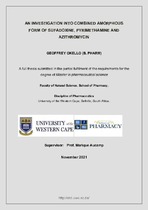| dc.contributor.advisor | Aucamp, Marique | |
| dc.contributor.author | Okello, Geoffrey | |
| dc.date.accessioned | 2022-02-21T12:59:43Z | |
| dc.date.issued | 2021 | |
| dc.identifier.uri | http://hdl.handle.net/11394/8720 | |
| dc.description | Magister Pharmaceuticae - MPharm | en_US |
| dc.description.abstract | Malaria remains one of the top mortality causes in the sub-Saharan African region, especially
among pregnant women and infants. Despite several measures being implemented within the
affected areas such as the use of treated mosquito nets, sulfadoxine and pyrimethamine (SULPYR)
as an intermittent preventive treatment (IPTp-SP) is still considered the standard
prophylactic regimen for pregnant women. Recently, the WHO increased the regimen of IPTp-
SP from three to four doses on a monthly interval, this recommendation poses a potential risk
of toxicity and resistance to the drugs. An improvement towards this challenge is under clinical
trial and consists of the inclusion of azithromycin (AZI), a macrolide antibiotic, to the current
IPTp-SP treatment regimen. This will not only aid in the prophylaxis of malaria in pregnant
women but will also assist in other pregnancy related infections. All three these drugs exhibit
poor aqueous solubility; requiring high concentrations for oral administration to achieve
therapeutic plasma concentrations. | en_US |
| dc.language.iso | en | en_US |
| dc.publisher | University of Western Cape | en_US |
| dc.subject | Malaria | en_US |
| dc.subject | sub-Saharan African | en_US |
| dc.subject | Pregnant women | en_US |
| dc.subject | Dissolution rate | en_US |
| dc.subject | Sulfadoxine | en_US |
| dc.title | An investigation into combined amorphous form of sufadoxine, pyrimethamine and azithromycin | en_US |
| dc.rights.holder | University of Western Cape | en_US |
| dc.description.embargo | 2024 | |

